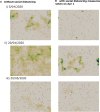Mathematical Modeling Predicts That Strict Social Distancing Measures Would Be Needed to Shorten the Duration of Waves of COVID-19 Infections in Vietnam
- PMID: 33520905
- PMCID: PMC7841962
- DOI: 10.3389/fpubh.2020.559693
Mathematical Modeling Predicts That Strict Social Distancing Measures Would Be Needed to Shorten the Duration of Waves of COVID-19 Infections in Vietnam
Abstract
Coronavirus disease 2019 (COVID-19) emerged in Wuhan, China in 2019, has spread throughout the world and has since then been declared a pandemic. As a result, COVID-19 has caused a major threat to global public health. In this paper, we use mathematical modeling to analyze the reported data of COVID-19 cases in Vietnam and study the impact of non-pharmaceutical interventions. To achieve this, two models are used to describe the transmission dynamics of COVID-19. The first model belongs to the susceptible-exposed-infectious-recovered (SEIR) type and is used to compute the basic reproduction number. The second model adopts a multi-scale approach which explicitly integrates the movement of each individual. Numerical simulations are conducted to quantify the effects of social distancing measures on the spread of COVID-19 in urban areas of Vietnam. Both models show that the adoption of relaxed social distancing measures reduces the number of infected cases but does not shorten the duration of the epidemic waves. Whereas, more strict measures would lead to the containment of each epidemic wave in one and a half months.
Keywords: COVID-19; SARS-CoV-2; basic reproduction number; epidemic model; multi-scale modeling.
Copyright © 2021 Bouchnita, Chekroun and Jebrane.
Conflict of interest statement
The authors declare that the research was conducted in the absence of any commercial or financial relationships that could be construed as a potential conflict of interest.
Figures








Similar articles
-
Mathematical assessment of the impact of non-pharmaceutical interventions on curtailing the 2019 novel Coronavirus.Math Biosci. 2020 Jul;325:108364. doi: 10.1016/j.mbs.2020.108364. Epub 2020 May 1. Math Biosci. 2020. PMID: 32360770 Free PMC article.
-
Impact of self-imposed prevention measures and short-term government-imposed social distancing on mitigating and delaying a COVID-19 epidemic: A modelling study.PLoS Med. 2020 Jul 21;17(7):e1003166. doi: 10.1371/journal.pmed.1003166. eCollection 2020 Jul. PLoS Med. 2020. PMID: 32692736 Free PMC article.
-
Mathematical modeling of the transmission of SARS-CoV-2-Evaluating the impact of isolation in São Paulo State (Brazil) and lockdown in Spain associated with protective measures on the epidemic of CoViD-19.PLoS One. 2021 Jun 15;16(6):e0252271. doi: 10.1371/journal.pone.0252271. eCollection 2021. PLoS One. 2021. PMID: 34129608 Free PMC article.
-
Quarantine alone or in combination with other public health measures to control COVID-19: a rapid review.Cochrane Database Syst Rev. 2020 Sep 15;9(9):CD013574. doi: 10.1002/14651858.CD013574.pub2. Cochrane Database Syst Rev. 2020. PMID: 33959956 Free PMC article.
-
Travel-related control measures to contain the COVID-19 pandemic: a rapid review.Cochrane Database Syst Rev. 2020 Oct 5;10:CD013717. doi: 10.1002/14651858.CD013717. Cochrane Database Syst Rev. 2020. Update in: Cochrane Database Syst Rev. 2021 Mar 25;3:CD013717. doi: 10.1002/14651858.CD013717.pub2. PMID: 33502002 Updated.
Cited by
-
Mathematical Modeling of COVID-19 Cases and Deaths and the Impact of Vaccinations during Three Years of the Pandemic in Peru.Vaccines (Basel). 2023 Oct 27;11(11):1648. doi: 10.3390/vaccines11111648. Vaccines (Basel). 2023. PMID: 38005980 Free PMC article.
-
Morocco's population contact matrices: A crowd dynamics-based approach using aggregated literature data.PLoS One. 2024 Mar 14;19(3):e0296740. doi: 10.1371/journal.pone.0296740. eCollection 2024. PLoS One. 2024. PMID: 38483954 Free PMC article.
-
Analysis of the COVID-19 pandemic using a compartmental model with time-varying parameters fitted by a genetic algorithm.Expert Syst Appl. 2023 Aug 15;224:120034. doi: 10.1016/j.eswa.2023.120034. Epub 2023 Apr 5. Expert Syst Appl. 2023. PMID: 37033691 Free PMC article.
-
Characterization of superspreaders movement in a bidirectional corridor using a social force model.Front Public Health. 2023 Jul 28;11:1188732. doi: 10.3389/fpubh.2023.1188732. eCollection 2023. Front Public Health. 2023. PMID: 37575110 Free PMC article.
-
Social distancing as a public-good dilemma for socio-economic cost: An evolutionary game approach.Heliyon. 2022 Nov 14;8(11):e11497. doi: 10.1016/j.heliyon.2022.e11497. eCollection 2022 Nov. Heliyon. 2022. PMID: 36411893 Free PMC article.
References
-
- Bouchnita A, Jebrane A. A multi-scale model quantifies the impact of limited movement of the population and mandatory wearing of face masks in containing the COVID-19 epidemic in Morocco. Math Model Nat Phenom. (2020) 15:13 10.1051/mmnp/2020016 - DOI
-
- Jia J, Ding J, Liu S, Liao G, Li J, Duan B, et al. Modeling the control of COVID-19: impact of policy interventions and meteorological factors. arXiv. (2020) 200302985.
-
- Volpert V, Banerjee M, Petrovskii S. On a quarantine model of coronavirus infection and data analysis. Math Model Nat Phenom. (2020) 15:24 10.1051/mmnp/2020006 - DOI
Publication types
MeSH terms
LinkOut - more resources
Full Text Sources
Other Literature Sources
Medical
Research Materials
Miscellaneous

